Compensation management and benefits (Human Resource Management)
Compensation management and benefits is vital function of human resource managing team of companies who operate at international level. It is very important to compensate employees for their contribution in business process of company. Compensation is explained as all forms of financial rewards received by employees. It begins from their employment. It occupies a significant position in the employee's personal and official life. It has a substantial cost to the managers. Compensation is major human resource tools that organizations utilize to manage their employees. For an organization to get its money worth and encourage and hold skilled employees, it needs to guarantee that its compensation system is not an island by itself. It is important for firm to link compensation to its general goals and strategies as well as its compensation system to align with its HR strategy.
Compensation Management is an organized practice that involves balancing the work-employee relation by providing monetary and non-monetary benefits to employees. Compensation includes payments such as bonuses, profit sharing, overtime pay, recognition rewards and sales commission. Compensation can also include non-monetary perks such as a company-paid car, company-paid housing and stock options. Compensation assists to motivate the employees and enhances organizational effectiveness. Compensation displeasure can lead to absenteeism, turnover, job dissatisfaction, low performance, strikes and grievances.
Importance of Compensation Management
Many studies have demonstrated that good compensation is essential for every industry and helps to give proper return to the workers for their contributions to the organization. It communicates a positive control on the competence of workers and encourages them to give their best and accomplish the specific standards. It forms a basis of pleasure and satisfaction for the workers that minimizes the labour turnover and presents a steady organization. It increases the job evaluation process which consecutively helps in establishing more realistic and achievable standards. It is planned to obey with the various labour acts and therefore does not result in disagreement between the worker union and the management. This builds up a peaceable relationship between the employer and the employees. It creates an environment of self-esteem, efficiency and cooperation among the workers and provides satisfaction to the workers. It motivates the employees to increase efficiency and show their excellence. It provides growth and development opportunities to the deserving employees.
Deluca (1993) and Rajkumar (1996) described that "compensation is defined as pay, reward, remuneration, or salary and wage management". These terms are often used interchangeably in organization. In an organization standpoint, compensation is as an important human resource management function where it emphasizes planning, organizing, and controlling various types of pay systems. For instance, direct and indirect payments, monetary and non-monetary rewards and cash and non-cash payments, those compensation is used for rewarding employees who perform in their work or service (Noe, Hollenbeck, Gerhart and Wright, 2004). In this study, compensation can be seen as a measure of justice. Normally, it is the major source of employees' financial security (Milkovich and Newman, 2008).
Benefits is defined as the part of the total compensation package provided to the employee in whole or in part by payments from the employer and it does not comprise of the pay for time spent on work (Milkovich& Newman, 2008). Moreover, benefits are group membership rewards that give security for workforce and their family member. Benefits are a non-compensation paid to employees. Some benefits are mandated by law, for example social security, unemployment compensation and worker compensation. Employees' benefits include pension, health insurance, fringe benefits, welfare etc (Lee, Hsu & Lien, 2006). Benefits are a vital part of an employee's total compensation package. Benefits packages became accepted after World War II, when wage controls made it more complex to give competitive salaries (Enotes.com, 2008). Benefits can be treated as the payment or entitlement, such as one makes under an insurance policy or employment agreement, or public assistance program or more generally, something of value or utility. Benefits may also be considered as an expression of justice in society (Herman, 2015).
Carter (2008) explained that "benefits are forms of value, other than payment, that are provided to the employee in return for their contribution to the organization, which is for doing their work". Employee's benefit includes disability income protection, retirement benefits, work-life balance (for example, sick leave, vacation, jury duty and etc), allowances (for example, dental, insurance, medical, transportation, housing, mobile phone and etc.). Carter (2002) anticipated that benefits are increasingly costly for businesses to provide to employees, so the range and options of benefits are varying quickly to include, such as flexible benefits plan. For employers, they use benefits to catch the attention and retain good and capable workers. For employees, they rely on benefits for example, medical subsidies, vacations, and retirement, to secure their financial status. By linking benefits such as, pension and holidays to seniority, workers will be unwilling to change jobs (Gerhart & Milkovich, 1992). Lee, Hsu and Lien (2006) said that benefits are planned to uphold employees and their family against problems due to sickness, accidents or retirements. There are many components of benefits to bring out its effect of employees. Work life balance such as temporal flexibility, leave benefits, and interpersonal relationships has the potential to decrease or increase strain on workers with life responsibilities. The condition of work life balance strategies can provide a positive and direct effect on an employee's choice to stay with an employer (Macran, Joshi &Dex, 1996). Milkovich & Newman (2008) stated that income protection assists to guard employees from the financial risks inbuilt in daily life. It serves as a support to employees' salaries in the event that an employee is sick, disabled, or no longer able to work. Workers allowances are extremely needed for employees. It helps to lessen the financial burden of employees and also can be treated as extra sum of salaries indeed (Herman, 2015). Therefore, a benefit has great consequence to the whole organizations.
It has been seen that major labour management clashes relate to compensation. Compensation is the extrinsic that employees receive in exchange for their work. It is composed of the base wage or salary and incentives or bonuses and benefit. Compensation is a key factor to attract and keep the best employees and ensuring that the organization has the competitive edge in a progressively more competitive world. The Compensation Management factor enables to distinguish between the payments strategies and those of competitors while still allowing flexibility, control and cost effectiveness. It provides a toolset for strategic remuneration planning that reveals the organization culture and pay strategies, and it makes powerful line managers within a framework of flexible budget control. Compensation management permit to control bottom line expenditures and competitive and motivating compensation, be it fixed pay, variable pay, stock options, merit increases, or promotion in other words, total compensation.
An employee's total compensation comprises of four components. The relative proportion of each constituent in the total compensation varies form firm to firm. The first and generally the major component is base compensation which means the fixed pay an employee receives on a regular basis, either in the form of a salary or as wages. The second component is allowances such as house rent allowance (HRA), dearness allowance (DA) and city compensatory allowance (CCA). The third component is incentive pay planned to reward employees for good performance, such as performance-linked bonus, share in profit, etc. The fourth component is benefits or indirect compensation or perquisites such as company accommodation, company car, paid holiday, club membership, stock options. Compensation is evenly important for the employee as it determines life standard and position in society. In other words, compensation has great impact on employees economically, socially and psychologically.
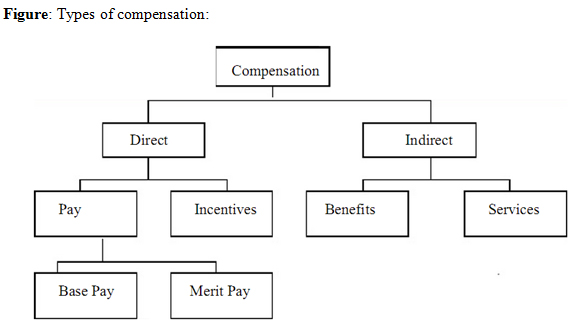
Compensation management consists of designing the lowest cost pay structure that will attract, keep, and stimulate the capable employees and which is perceived as fair by the employee satisfaction. The major purposes of compensation management are as follows:
- A perfect compensation system will have positive impact on the competence and results produced by employees. It will encourage the employees to perform better and achieve the standards fixed.
- Compensation will raise the confidence, efficiency and cooperation among the workers. Being just and fair will provide satisfaction to the workers.
- Good compensation and Rewards system bring harmony in the relationship of manager and employees, collective bargaining generally focus on compensation issues.
- The ideal compensation system provides stand for cheerful and satisfied personnel. This minimizes the labour turnover. The organization becomes stable in marketplace.
- The industry can devise compensation strategy and growth if it has the support of skilful, talented and happy workforce.
- The effective compensation system is characteristic of organization success and wealth.
- The success and constancy of the organization is measured with pay-package it provides to its employees.
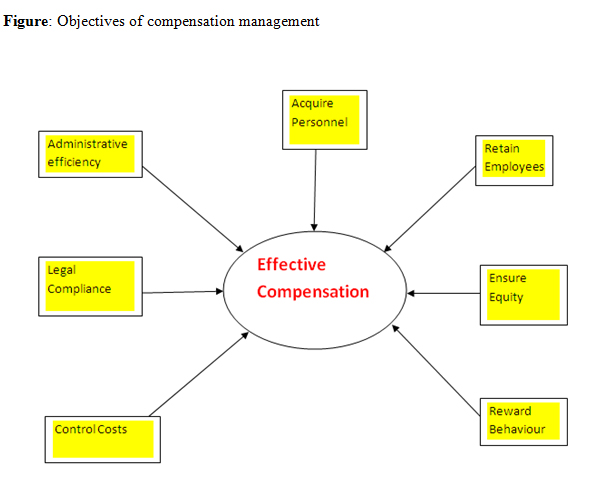
Components of compensation
Financial compensation package of employees comprises of the following components:
- Basic Pay. The main part of pay package is basic pay. For blue-collar workers basic wage may be based on work done (price wage system) but for white-collar employees, supervisory staff and managers, basic salary is generally time bound. Basic pay is generally determined through job evaluation which is the process of systematically ascertaining the relative worth of a job.
- Allowances. Several allowances are paid in addition to basic pay. Some of these allowances are given below:
- Dearness Allowance: This allowance is given to protect real income against inflation. Generally, dearness allowance (DA) is paid as a percentage of basic pay.
- House Rent Allowance: Employers who do not provide living accommodation and pay house rent allowance (HRA) to employees. This allowance is calculated as a percentage of basic pay (Percentage varies according to Class of city from 10% to 35% of basic pay in case of government employees).
- City Compensatory Allowance: This allowance is paid generally to employees in metros and other big cities where cost of living is comparatively high. City compensatory allowance (CCA) is generally a fixed amount per month.
- Transport Allowance/Conveyance Allowance: Some employers pay transport allowance (TA) to their employees. A fixed sum is paid every month to cover a part of traveling charges.
- Incentives: Incentive compensation is performance-linked remuneration paid with the aim to encourage employees to work more and perform better. Both individual incentives and group incentives are used. Bonus, profit-sharing, commissions on sales are some examples of incentive compensation.
- Fringe Benefits/Perquisites: Different types of benefits are paid particularly to senior managers. Provident funds, pensions, gratuity, encashment of earned leave, company house, company car, leave travel concession (LTC), medical aid, interest free loan, holiday homes, entertainment, stock options, etc. are examples of such benefits.
In some cases, medical allowance, education allowance for children, Tiffin allowance are also paid.
Needs of compensation management
- A good compensation package is significant to stimulate the employees to increase the organizational productivity.
- Compensation is provided to work for the organization. Compensation helps in running an organization successfully and to achieve its goals.
- Salary is just a part of the compensation system, the employees have other psychological and self-actualization needs to fulfil. Thus, compensation serves the purpose.
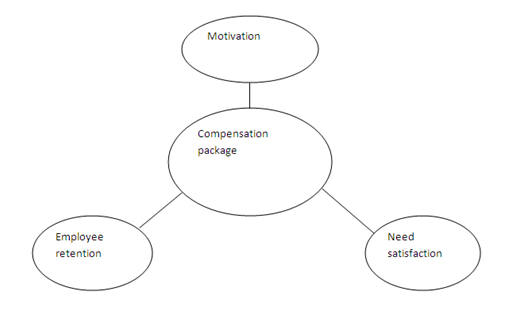
Major phases of compensation management
Compensation Management consists of four phases which are shown with the help of diagram given below
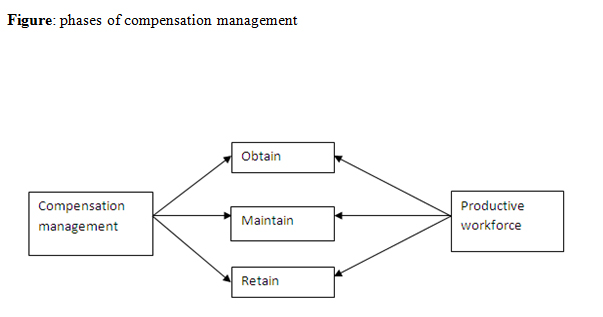
Compensation challenges: HR experts in most of the companies have major compensation-related concerns. Most specifically, the problem is money. Compensation structures are major issue for human resources departments in all types of organizations. Another problem for HR professionals is a compensation budget and salery. Key issues are depicted in below figure.
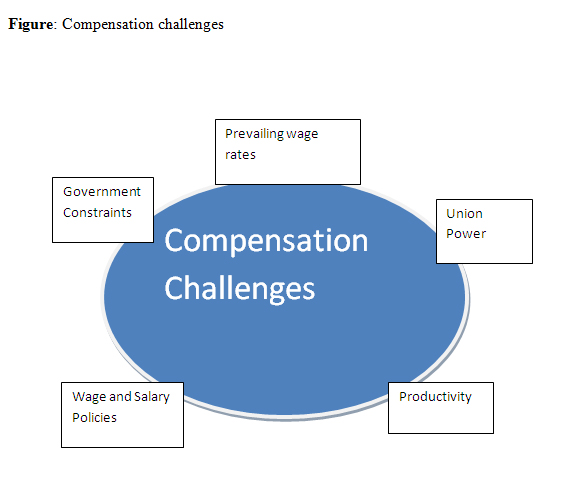
Relation between compensation and benefit:presently, compensation and benefits are growing fields in Human Resources. Most of the company scrutinize various ways of rewarding employees to boost their job satisfaction and their performance. Compensation is a type of financial return and concrete services and benefits employees receive as part of an employment relationship, which includes topics in regard to wages or salary programs; for example, salary ranges for job descriptions, merit based programs, bonus based programs, commission based programs, long term or short terms incentives programs. Employee's benefit comprises of the allowances, income protection, life insurances, life balance, and vacation. Benefits are forms of value, other than payment, that are given to the employee in return for their work to the organization. Employers must design a suitable compensation and benefits system to their workers. This is because unsuitable compensation and benefits will have unhelpful effect to employee job satisfaction. Compensation and benefits is dominant tools of organizational goals and priorities and companies that expect to be successful must make employees become partners in their success (Shuster &Zingheim, 1993). Pam (2007) scrutinized that employee compensation can be a sensitive subject, and people get very passionate when trying to determine the most appropriate compensation plan for any business. Today, many human resources related issues need to be addressed, but equally important is to understand the financial aspects of employee compensation and benefits. Consequently, compensation and benefits is major part of an organization.
To summarize, compensation is human resource mechanism that organizations use to manage their workforce. Compensation emphasizes fair day pay for fair day work. Compensation and benefits are more multifarious than simple remuneration. Many staff considers professional development, workplace culture, and other benefits when assessing workplace satisfaction.

